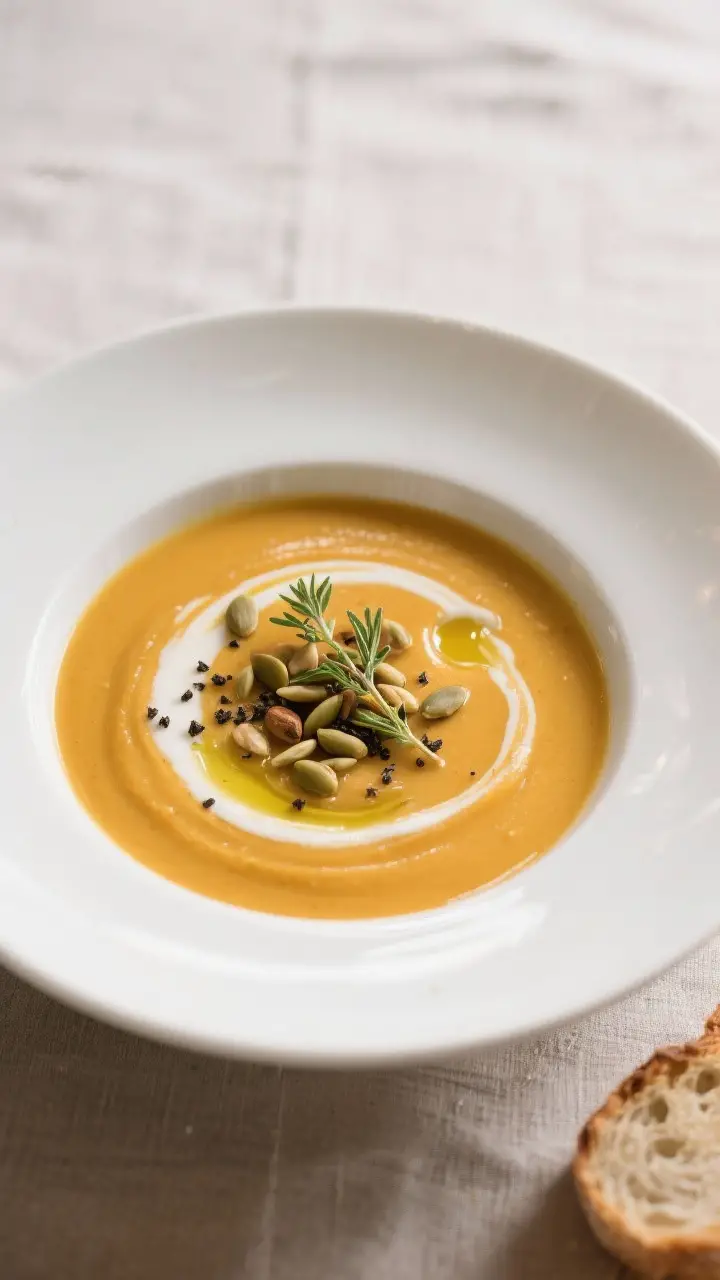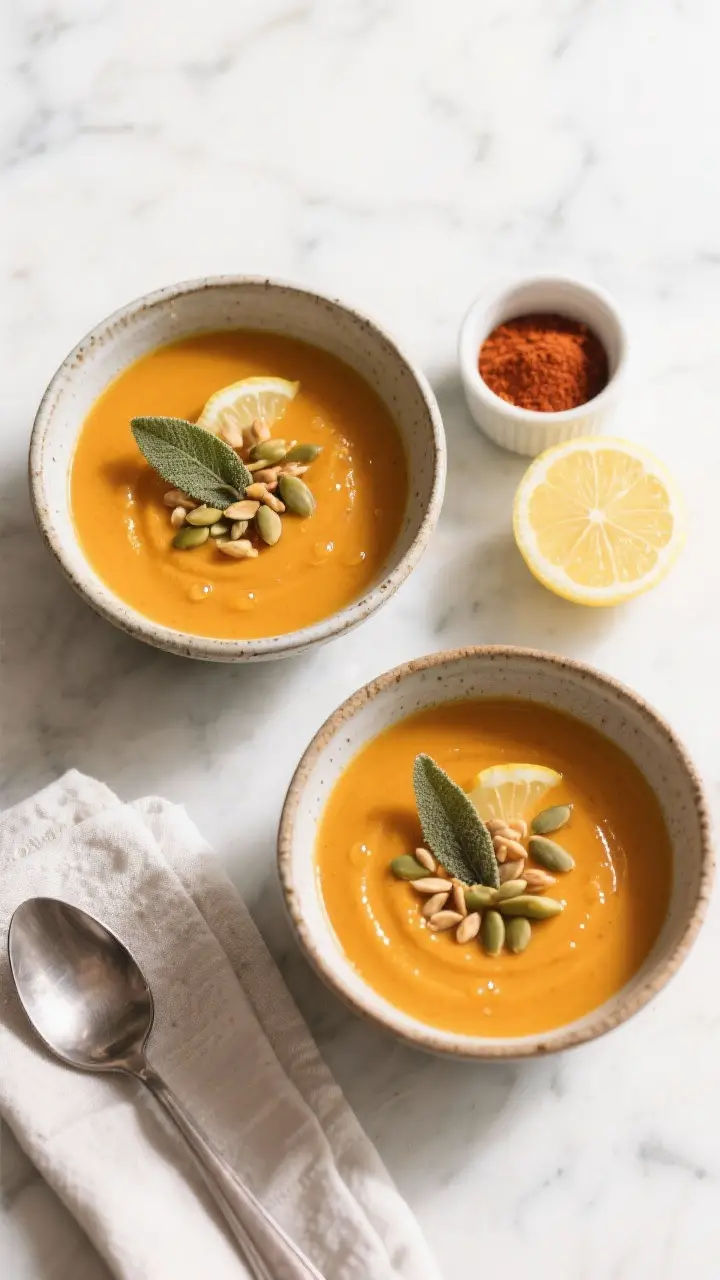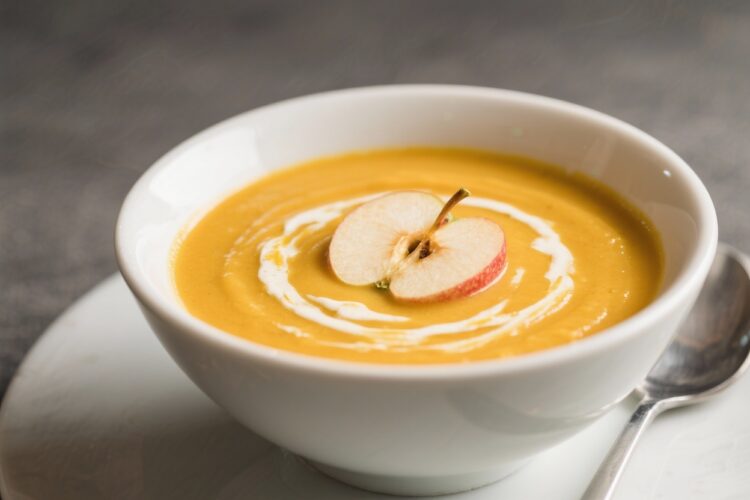Imagine a soup that gives you fall vibes, fuels your day, and makes your kitchen smell like a million-dollar cafe. That’s Apple Butternut Soup. It’s the kind of recipe that makes your friends think you hired a private chef, but you secretly spent under an hour and used pantry basics.
It’s creamy without cream, sweet without sugar, and fancy without fuss. If comfort food had a winning startup pitch, this would be it.
What Makes This Recipe So Good

This soup balances sweet apples with nutty butternut squash and savory aromatics for a flavor profile that’s layered, not sugary. The texture is velvety thanks to a quick blend, and you control the richness with your choice of broth and finishers.
It’s also incredibly flexible: make it vegan, make it spicy, or make it kid-friendly. Plus, it reheats like a dream, so your future self will thank you on a busy weeknight.
Another win: it’s economical. Butternut squash and apples are budget-friendly, and the recipe turns basic produce into something dinner-party-worthy.
It’s also naturally gluten-free and can be dairy-free with zero sacrifice. That means more people at your table can enjoy it—no complicated swaps or mystery ingredients required.
Shopping List – Ingredients
- 1 large butternut squash (about 3 pounds), peeled, seeded, and cubed
- 2 medium apples (Honeycrisp, Gala, or Fuji), cored and chopped
- 1 large yellow onion, chopped
- 2 cloves garlic, minced
- 1 medium carrot, chopped (optional for extra sweetness and color)
- 2 tablespoons olive oil or unsalted butter
- 1 teaspoon kosher salt (plus more to taste)
- 1/2 teaspoon freshly ground black pepper
- 1/2 teaspoon ground cinnamon
- 1/4 teaspoon ground nutmeg
- 1/4 teaspoon smoked paprika or cayenne (optional for heat)
- 4 cups low-sodium vegetable or chicken broth
- 1/2 cup coconut milk or heavy cream (optional for extra creaminess)
- 1 tablespoon maple syrup (optional; use only if apples are very tart)
- Juice of 1/2 lemon or 1 tablespoon apple cider vinegar
- Fresh thyme or sage leaves for garnish
- Pepitas (toasted pumpkin seeds) or croutons for topping
Instructions

- Prep the produce. Peel and cube the butternut squash. Chop the apples, onion, and carrot.
Mince the garlic. Keep everything roughly the same size so it cooks evenly.
- Sweat the aromatics. In a large pot or Dutch oven, heat the olive oil/butter over medium heat. Add onion and carrot with a pinch of salt.
Cook 5–7 minutes until softened and lightly golden around the edges.
- Build the base. Stir in garlic, cinnamon, nutmeg, and smoked paprika or cayenne (if using). Cook 30 seconds until fragrant—don’t let the garlic brown.
- Add squash and apples. Toss to coat with the spices. Season with salt and pepper.
This step layers in flavor so you’re not relying solely on the broth.
- Pour in the broth. Add enough broth to just cover the vegetables (about 4 cups). Bring to a boil, then reduce to a lively simmer.
- Simmer until tender. Cook 18–22 minutes, until the squash pierces easily with a fork and the apples are soft. Taste the broth—it should be balanced and aromatic.
- Blend until silky. Use an immersion blender directly in the pot, or carefully transfer to a blender in batches.
Blend until ultra-smooth. If it’s too thick, add a splash of broth or water.
- Finish and adjust. Stir in coconut milk or heavy cream if using. Add lemon juice or apple cider vinegar for brightness.
If your apples were very tart, add up to 1 tablespoon maple syrup. Taste and adjust salt and pepper.
- Garnish and serve. Ladle into bowls. Top with toasted pepitas, a drizzle of cream or olive oil, and fresh thyme or sage.
Serve with crusty bread, grilled cheese, or a simple salad.
Preservation Guide
- Fridge: Store cooled soup in an airtight container for up to 5 days. It thickens slightly as it chills; loosen with broth or water when reheating.
- Freezer: Freeze in quart containers or freezer bags for up to 3 months. Leave headspace for expansion.
Thaw overnight in the fridge.
- Reheat: Warm gently on the stove over low-medium heat, stirring often. Avoid boiling if you’ve added dairy to prevent separation.
- Meal prep tip: Portion into single-serve containers for grab-and-go lunches. FYI, it reheats faster in shallow containers.

What’s Great About This
- Balanced flavor: Sweet, savory, and subtly spiced—no one-note sweetness.
- Nutrition-forward: Rich in fiber, vitamins A and C, and satisfying without being heavy.
- Flexible diet-wise: Naturally gluten-free; easy to make vegan or dairy-free.
- Batch-friendly: Doubles easily, freezes beautifully, and stays silky.
- Entertaining-worthy: Looks and tastes luxurious with minimal effort.
We love a high ROI recipe.
Common Mistakes to Avoid
- Over-sweetening: Apples and squash are already sweet. Add maple syrup only if needed, and just a touch.
- Skipping acid: Without lemon juice or vinegar, the soup can taste flat. A little acidity brightens everything.
- Not seasoning in layers: Salt at multiple stages—aromatics, simmer, and finish.
It’s the difference between “good” and “wow.”
- Boiling after adding dairy: This can cause curdling or a grainy texture. Gentle heat is your friend.
- Uneven chopping: Different sizes mean uneven cooking, which leads to lumpy blending or overcooked bits.
Variations You Can Try
- Spiced Moroccan: Add 1 teaspoon ras el hanout or 1/2 teaspoon each cumin, coriander, and cinnamon. Finish with a swirl of yogurt and chopped cilantro.
- Thai-Inspired: Stir in 1–2 tablespoons red curry paste with the aromatics and use coconut milk.
Garnish with lime and basil. Heat level: your call.
- Maple Sage: Fry fresh sage leaves in butter until crisp. Stir sage butter into the soup and add a light drizzle of maple.
- Roasted Depth: Roast the squash and apples at 425°F with oil and salt until caramelized, then proceed.
Extra work, big payoff.
- Protein Boost: Top with shredded rotisserie chicken, crispy chickpeas, or seared tofu for a more filling bowl.
- Smoky Bacon: Cook 3–4 strips of bacon first, remove and crumble, then sauté aromatics in the rendered fat. Garnish with bacon bits.
FAQ
What kind of apples work best?
Use firm, mildly sweet varieties like Honeycrisp, Gala, Fuji, or Pink Lady. Avoid mealy apples like Red Delicious.
If you prefer a more tart note, mix one sweet apple with one Granny Smith.
Do I need to peel the apples?
You don’t have to, but peeling yields a smoother texture and cleaner color. If you keep the peel on, blend thoroughly and strain if needed for an ultra-silky finish.
Can I make this without a blender?
You’ll get the best results with an immersion blender or countertop blender. In a pinch, mash with a potato masher for a rustic texture.
It won’t be perfectly smooth, but it’ll still taste great.
How do I make it vegan?
Use olive oil, vegetable broth, and coconut milk (or skip the creamy add-in entirely). The soup remains rich and satisfying—no dairy required.
Can I use pre-cut squash?
Absolutely. Pre-cut squash saves time and sanity.
Just ensure the pieces are evenly sized so they cook at the same rate.
Why add lemon juice or vinegar at the end?
Acidity sharpens flavors and balances sweetness. It’s the small tweak that makes the soup taste professional. IMO, it’s non-negotiable.
How can I thicken or thin the soup?
For thicker soup, simmer uncovered for a few minutes to reduce or add a small cooked potato before blending.
For thinner soup, stir in warm broth or water a little at a time until you hit your ideal texture.
Is it spicy?
Not by default. The optional smoked paprika or cayenne adds a gentle kick. Adjust to your heat tolerance, because you’re the boss here.
Final Thoughts
Apple Butternut Soup is the culinary equivalent of a weighted blanket—comforting, grounding, and surprisingly energizing.
It converts simple produce into a silky, layered bowl you’ll make on repeat. Keep it classic, dress it up with herbs and toppings, or spin it global with a spice twist. Your weeknight rotation just got a serious upgrade, and your leftovers?
Elite, FYI.
Printable Recipe Card
Want just the essential recipe details without scrolling through the article? Get our printable recipe card with just the ingredients and instructions.

